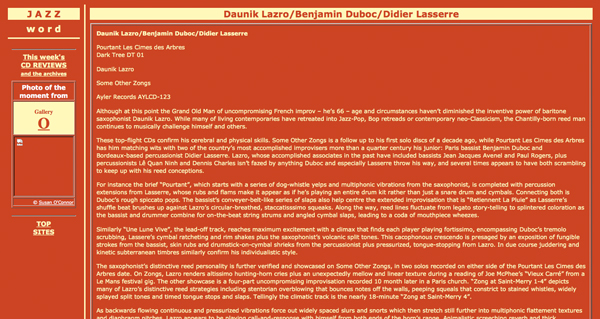• Chronique par Ken Waxman sur Jazz Word (25 janvier 2012)
Daunik Lazro/Benjamin Duboc/Didier Lasserre
Pourtant Les Cimes des Arbres
Dark Tree
Daunik Lazro
Some Other Zongs
Ayler Records
Although at this point the Grand Old Man of uncompromising French improv – he’s 66 – age and circumstances haven’t diminished the inventive power of baritone saxophonist Daunik Lazro. While many of living contemporaries have retreated into Jazz-Pop, Bop retreads or contemporary neo-Classicism, the Chantilly-born reed man continues to musically challenge himself and others.
These top-flight CDs confirm his cerebral and physical skills. Some Other Zongs is a follow up to his first solo discs of a decade ago, while Pourtant Les Cimes des Arbres has him matching wits with two of the country’s most accomplished improvisers more than a quarter century his junior: Paris bassist Benjamin Duboc and Bordeaux-based percussionist Didier Lasserre. Lazro, whose accomplished associates in the past have included bassists Jean Jacques Avenel and Paul Rogers, plus percussionists Lê Quan Ninh and Dennis Charles isn’t fazed by anything Duboc and especially Lasserre throw his way, and several times appears to have both scrambling to keep up with his reed conceptions.
For instance the brief “Pourtant”, which starts with a series of dog-whistle yelps and multiphonic vibrations from the saxophonist, is completed with percussion extensions from Lasserre, whose rubs and flams make it appear as if he’s playing an entire drum kit rather than just a snare drum and cymbals. Connecting both is Duboc’s rough spiccato pops. The bassist’s conveyer-belt-like series of slaps also help centre the extended improvisation that is “Retiennent La Pluie” as Lasserre’s shuffle beat brushes up against Lazro’s circular-breathed, staccatisssimo squeaks. Along the way, reed lines fluctuate from legato story-telling to splintered coloration as the bassist and drummer combine for on-the-beat string strums and angled cymbal slaps, leading to a coda of mouthpiece wheezes.
Similarly “Une Lune Vive”, the lead-off track, reaches maximum excitement with a climax that finds each player playing fortissimo, encompassing Duboc’s tremolo scrubbing, Lassere’s cymbal ratcheting and rim shakes plus the saxophonist’s volcanic split tones. This cacophonous crescendo is presaged by an exposition of fungible strokes from the bassist, skin rubs and drumstick-on-cymbal shrieks from the percussionist plus pressurized, tongue-stopping from Lazro. In due course juddering and kinetic subterranean timbres similarly confirm his individualistic style.
The saxophonist’s distinctive reed personality is further verified and showcased on Some Other Zongs, in two solos recorded on either side of the Pourtant Les Cimes des Arbres date. On Zongs, Lazro renders altissimo hunting-horn cries plus an unexpectedly mellow and linear texture during a reading of Joe McPhee’s “Vieux Carré” from a Le Mans festival gig. The other showcase is a four-part uncompromising improvisation recorded 10 month later in a Paris church. “Zong at Saint-Merry 1-4” depicts many of Lazro’s distinctive reed strategies including stentorian overblowing that bounces notes off the walls, peeping squeals that constrict to stained whistles, widely splayed split tones and timed tongue stops and slaps. Tellingly the climatic track is the nearly 18-minute “Zong at Saint-Merry 4”.
As backwards flowing continuous and pressurized vibrations force out widely spaced slurs and snorts which then stretch still further into multiphonic flattement textures and diaphragm pitches, Lazro appears to be playing call-and-response with himself from both ends of the horn’s range. Animalistic screeching reverb and thick pedal-point timbres ultimately settle into mid-range glissandi and subtle saxophone body shakes.
From the evidence on these CDs, Lazro`s skills are evidentially improving with age – like the flavour of high-quality wine.
• • • • • • • • • • • • • • • • • • • • • • • • • • • • • • • • • • • • • • • • • • • • • • • • • • • • • • • • • • • • • • • •

Sorry, the comment form is closed at this time.